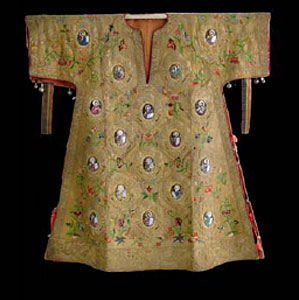Aufsatz/Buch
Karydis, Christos; Karapanagiotis, Ioannis:
Ecclesiastical Garments of Mount Athos. History, Typology and Colouring Matters
30.05.2008
zum Download
DOI (Digital Object Identifier)
Beteiligte, Autor/inn/en:

Selected artwork included in the study: Sakko of Patriarch Dionysiou IV Mouselimi
(i) stylistic development, design (mainly from France and Italy) and constructional modifications over time leading to a dating typology,
(ii) comparison of binding systems; exploration of possible 'signatures' leading to identification of provenance of specific workshops and finally
(iii) techniques and materials employed for the production and decoration of the sakkoi.
The latter were investigated by using FTIR and high performance liquid chromatography with UV-Vis photodiode array detection. The following organic dyes were identified in the silk extracts of the historical objects: dyer’s broom (Genista tinctoria L.), young fustic (Cotinus coggygria Scop.), an indigoid dye source either indigo (Indigofera species) or woad (Isatis tinctoria L.), madder (most likely Rubia tinctorum L.), cochineal and lac (Kerria lacca Kerr). Also, the identification of a brazilein derivative indicates the presence of a Caesalpinia dye source in the samples. The chemical results obtained for the garment extracts are compared with corresponding analytical data collected for post-Byzantine icons from the area of Chalkidiki (including Mount Athos). The comparison leads to some very interesting conclusions regarding the use of natural organic dyes in the post-Byzantine dyeing industry and post-Byzantine iconography.
Contribution of the 9th International Conference on Art 2008.
Non-destructive investigations and microanalysis for the diagnostics and conservation of cultural and environmental heritage.
by Israel National Commission for Unesco
Mor information on http://www.isas.co.il/art2008/
Download
Volltext zum Download (pdf-Format, ca. 0.25 MB)
![]() Dieses Werk steht unter einer
Creative Commons BY-NC-ND 3.0 Deutschland Lizenz.
Dieses Werk steht unter einer
Creative Commons BY-NC-ND 3.0 Deutschland Lizenz.
DOI (Digital Object Identifier)
10.5165/hawk-hhg/207
Beteiligte, Autor/inn/en:
- Christos Karydis (Autor/in)
University of Lincoln, Conservation Department, - Ioannis Karapanagiotis (Autor/in)
ORMYLIA Art Diagnosis Centre